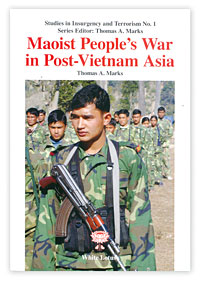|
|
Maoism is the most effective method of asymmetrical warfare yet devised, says US military adviser-turned-academic Thomas A Marks in a book that compares the post-Vietnam cases of Thailand, Philippines, Sri Lanka, Nepal and Peru.
After his Masters thesis on the Malayan insurgency and a PhD on the Thai conflict, Marks spent time here studying the Nepal war. He now teaches irregular warfare at the Washington-based National Defence University.
While Mao broke down the "people\'s war" into its components (mass line, united front, violent action, political warfare and international solidarity) Marks says one needn't be a Maoist to follow these techniques.
As in Iraq, Afghanistan or Sri Lanka, an insurgency is armed politics and a protracted political and military struggle meant to weaken government control so as to seize power. For Mao, legitimacy for such a struggle could only come from popular support to sustain the movement.
Marks says looking at the present peace process in Nepal, one can\'t be sure that this will lead to a permanent settlement. Usually, negotiated peace in insurgencies happens when the loser is willing to talk or both sides are so badly mauled that they come to the negotiation table. Neither has happened in Nepal.
\'Advocating talks as a solution sidesteps the crucial issue of insincerity,\' Marks concludes about Nepal's peace process.
The impetus for the Maoist entry into negotiations had two factors: the international climate (mainly India) as well as the realisation on the part of the leadership that despite their own rhetoric the insurgency had failed in Mao\'s main condition: it had lost popular support.
The book analyses how in the post-Cold War era Maoism has taken on terrorist tactics as an insurgent weapon of choice. He takes Sri Lanka as an example of this, not just the JVP uprising in the south but also the Tiger separatist war as being essentially waged by Mao\'s rules.
The other factor that has made Maoism more wildly successful in the 21st century than anything Mao predicted is the impact of state failure. \'Peru and Nepal displayed a lack of state capacity beyond anything Mao could have imagined,\' writes Marks.
Revolution was made much easier for modern Maoists in Nepal and Peru because the class enemy was so corrupt, disunited and feckless. Despite dense writing and fuzzy maps, the latest edition of Marks\' book is a worthwhile comparative study of the challenges of modern Maoism. By far the longest and most detailed chapter is on Nepal and while there may be points on which Marks can be taken to task, it does give us a perspective on the contradictions we see in our Maoists during the peace process.
Kunda Dixit



